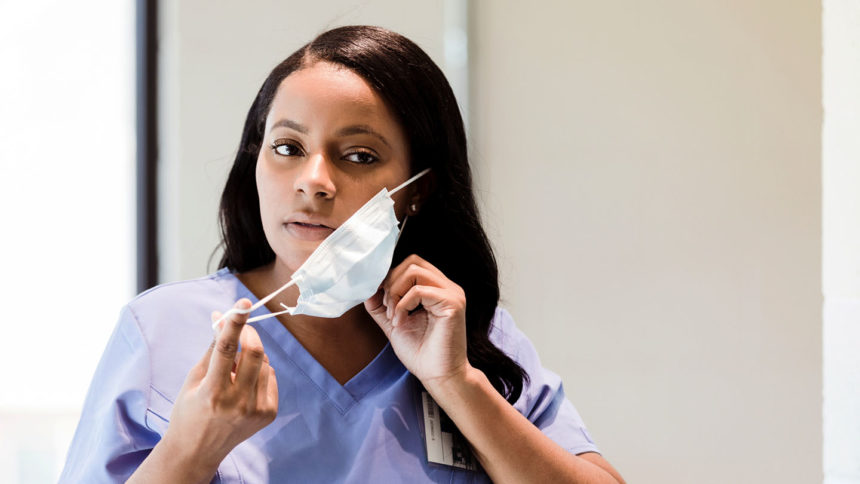
While masking and screening of nursing home workers and visitors may no longer be required in areas with lower COVID-19 transmission rates, vaccination and testing efforts will be crucial if providers hope to maintain new operating freedoms, federal health experts warned Monday.
The Centers for Disease Control and Prevention updated its information for healthcare providers late Friday, retiring sometimes-controversial guidance that recommended more stringent mitigation measures in nursing homes than in any other setting.
The revocation of broad masking requirements is among the biggest changes. Most staff can now skip wearing a respirator, face mask or eye protection when delivering care as long as the facility they are working in is in a county with low, moderate or even substantial transmission. They should still use them, however, around any kind of respiratory infection, after a known COVID-19 exposure, and when working in a healthcare unit with a COVID outbreak — which is identified by the CDC as a single case or more.
“If you are not in a high community-transmission area, you may remove your source control,” said Jodi Eyigor, LeadingAge director of nursing home quality and policy while breaking down the guidance on a call with provider members Monday. “Huge news!”
Universal source control precautions are still recommended in areas with high community transmission. Multiple studies during the course of the pandemic found that nursing home outbreaks were often tied to high transmission in surrounding areas.
Another important change: The CDC said it would no longer implement prevention and mitigation guidance based on individuals’ vaccination status. That came as a relief to some providers, who had worried that the Centers for Medicare & Medicaid Services might adopt a requirement around “up-to-date” vaccine status.
“Fully vaccinated is still the requirement for the mandate. It means that up-to-date, with that new definition starting today with that bivalent booster, is still required for your NHSN reporting,” Eyigor explained. “You’re no longer going to be using it to determine your prevention and mitigation strategies, but of course, it’s still important. We want to make sure that everybody is staying up-to-date with their COVID vaccination status because that’s going to help keep case numbers down and by all means, it’s going to help us keep those community levels in check where we’re not straining our health systems.”
Finally removing barriers
The recommendations took effect immediately, with CMS also issuing new memos to state surveyors on Friday to bring its requirement and guidance into alignment with that now backed by the CDC.
Providers have been clamoring for such changes for at least six months, especially as average cases became milder and hospitalizations fell.
Denise Winzeler, RN, LNHA, curriculum development specialist for AAPACN, said the latest guidance was being welcomed by residents and staff alike.
“The less stringent recommendations for face coverings and quarantining of residents leaving the facility for 24 hours or less will have a positive impact on their well-being by removing barriers to socialization,” she told McKnight’s Long-Term Care News Monday. It is also especially important for residents with dementia to see facial expressions and connect with others who can offer comfort when moving to a new place, so they will benefit considerably from this change.”
In addition to reducing quarantine recommendations, the guidance allows facilities to consider doing away with their COVID units or isolation areas, as well as staff designated to work with COVID-infected patients.
That’s a recognition that many nursing homes now have too few sick residents to support special units, on top of ongoing staffing challenges. Instead, residents with COVID should be kept in private rooms.
New ideas on quarantining
Quarantining for both staff and visitors will be reduced, too. The reduction applies to new admissions, readmissions and to those who are exposed.
“However, you still want to be testing these folks,” noted Eyigor, who explained that the tests would be more limited in nature than previous requirements for everyday testing. Now, new or readmitted residents and exposed residents or staff will need three viral tests each, and they do not need to be tested if they’ve recovered from COVID within 30 days.
That’s a boon to resource-strapped providers, added Winzeler.
“The updated guidance is a less burdensome process, allowing staff to use resources that focus on providing quality care,” she said. “At times, providers continue to struggle with securing enough testing supplies, which puts them at risk for noncompliance. These changes may alleviate some of the demand for testing supplies and allow the supply to catch up to the demand.”
In addition, providers may find they’re able to reduce front desk staffing, given that they no longer need to check in everyone who enters.
“You don’t have to have a live body at the front desk anymore screening people for COVID symptoms or exposure, or you don’t have to use your electronic monitoring systems. You could, of course, elect to do so,” Eyigor said. “There might be a time in the future when public health says you should be doing that, but as of now, CDC says you can switch to a passive screening where you have signs indicating what folks should be looking out for.”
She noted that CMS in its memos indicates special requirements for alerting staff to their requirements to report exposure or positive tests.




